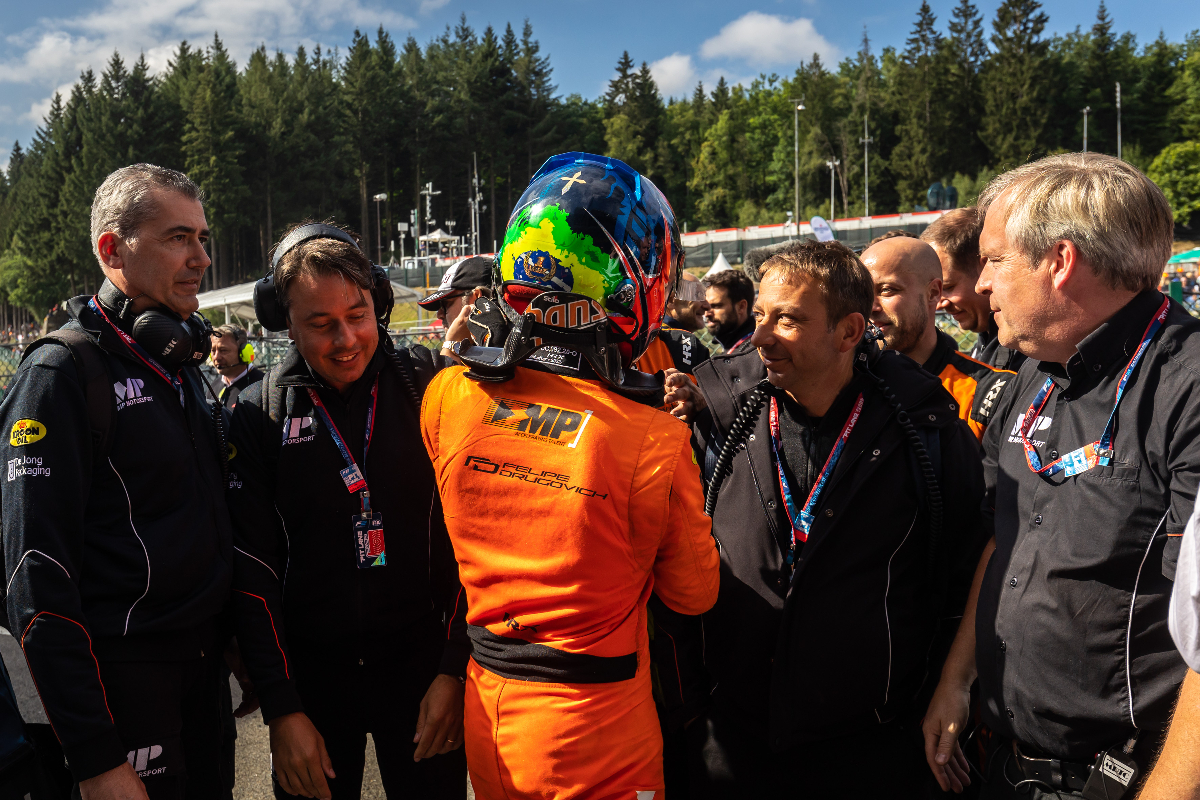
Photos: Dutch Photo Agency, L-R: Rossi, Oselladore, Angilella & Cotterill
MP Motorsport has raced in F2 and its predecessor GP2 since 2013, but not been a consistent contender for wins in high-level single-seaters until 2022, as a plan years in the making came to fruition
Felipe Drugovich has already been crowned 2022 Formula 2 champion, and his team MP Motorsport is going into the final round in a position to win both of this year’s titles in Formula 1’s primary feeder series.
Aston Martin-backed Drugovich has a 77-point margin at the top over ART Grand Prix’s Theo Pourchaire, and won four times in the first 10 rounds. The last time a driver had that many wins that early in a F2 campaign was Charles Leclerc in 2017.
George Russell only took a little longer in 2018, and those two champions were both rookies. Drugovich is in his third year racing in F2, but the difference between himself and past champions is not neccessarily his experience, but how he has applied it. Leclerc and Russell came into F2 with the top team, whereas Drugovich joined MP when it was more of a midfield operator in 2020, and the work he did then and the relationship he renewed for 2022 has helped lift the team to the top.
Drugovich arrived at MP for the first time after doing the inaugural FIA Formula 3 Championship season with an underperforming Carlin and scoring just once. That lowered expectations of the Brazilian, despite his domination of Euroformula in 2018, and he felt switching across to FIA F3 actually stunted his development.
However that pain, which he has since described as “being punched in the face every race”, was worth it because it meant he had experience of Pirelli’s fickle F1-style tyres before going into F2. Marino Sato succeeded Drugovich as Euroformula champion and headed straight to F2, but was on the back foot from the off with the tyres demands being so alien to him.
2019 was a far better year on MP’s side in FIA F3, although not in F2 with the struggling Mahaveer Raghunathan, as Liam Lawson claimed two podiums during the season and then Richard Verschoor won the World Cup at the Macau Grand Prix. A level of individual brilliance earned Verschoor that success, and Lawson charged from 20th to seventh too, as the team was unable to point out post-race what in its car set-up had enabled it to be so competitive.

Driving the team’s third car that weekend was Lukas Dunner, arriving from Euroformula with Paolo Angilella coming in his wake. Angilella had engineered Felix Rosenqvist and Mick Schumacher to FIA European F3 titles with Prema, but he was unable to apply his expertise track-side in Macau as he served gardening leave.
Following Angilella to MP for 2020 was veteran F2 engineer Daniele Rossi, who engineered alongside him at Prema in European F3, and their combined inputs set MP on its way with a three-year plan to improve its top two race programmes.
The delayed start to the 2020 season due to the COVID-19 pandemic gave MP more time to put new working practices into place, and it reaped the rewards almost as soon as F2 returned to track at the Red Bull Ring that summer as Drugovich won the sprint race. A pole and three more wins followed that year, as well as an incredible feature race win for Nobuharu Matsushita at Barcelona from 18th on the grid.
- Matsushita explains how he took ‘five-star’ win Feature: The F2 winners who started further back than Matsushita
Virtuosi’s title-fighting pace meant Drugovich found it a “logical choice” to move there for 2021, much to MP’s dissapointment as it “couldn’t get an agreement over the line” to retain him. But the season at Virtuosi didn’t go to plan, with Drugovich saying at the end of the year “I knew that I didn’t have the speed in some of the races, but I was trying to compromise for that by being too aggressive and it just wasn’t working”.
A phone call explaining how its three-year plan had progressed convinced him to return to MP, which was “probably the best step I made in my career” as by coming back to the team he became “a more relaxed driver”. The rest is history.
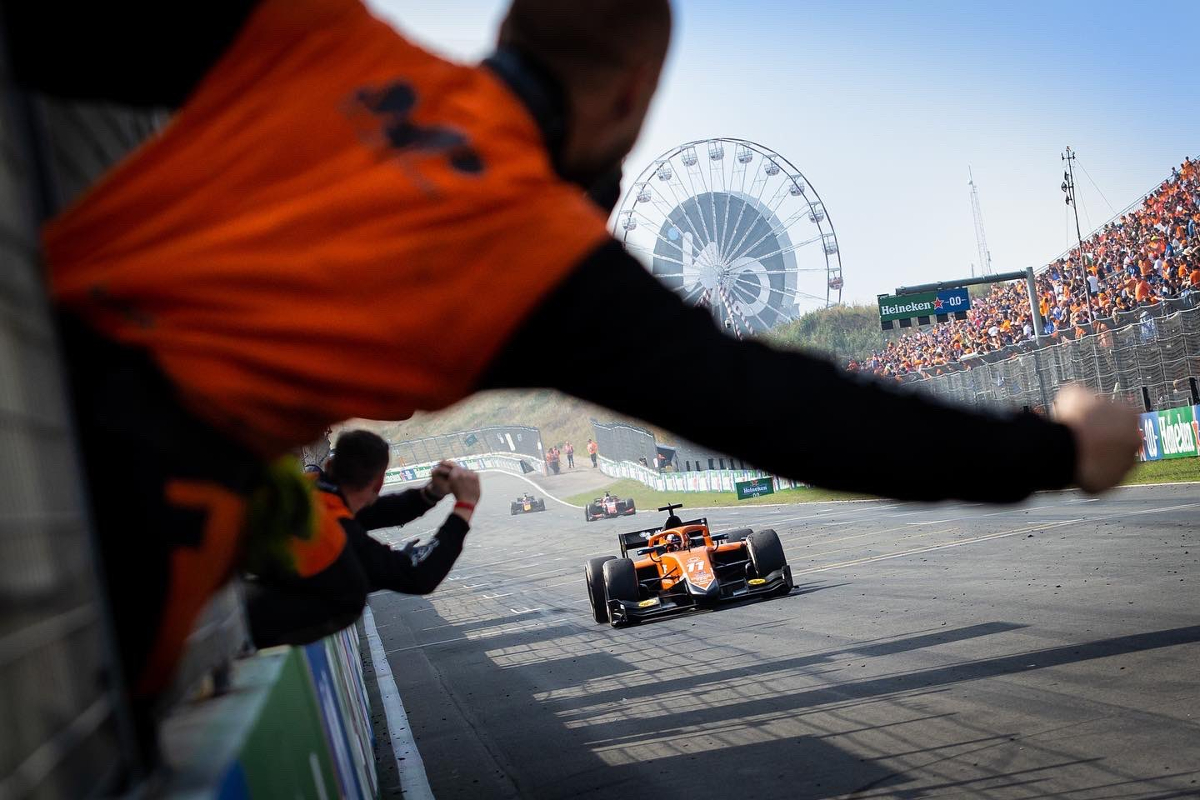
- Feature: F2 data analysis: MP’s pace promise finally shown in Saudi (April 2022)
Formula Scout asked Drugovich for his personal take on the impact that Angilella, Rossi and December 2021 signing Mattia Oselladore, formerly Prema’s European F3 technical director and Drugovich’s 2022 race engineer, has had on the team.
“I think it’s been great,” he replied. “Since 2020 that I joined them, I already talked many times that the team had a lot of potential. It showed a little bit but not all of it in 2020 because some of them were new to F2, so it was a little bit difficult.
“But then they improved a little bit more for last year and this year, also with new people coming in, with Mattia now, I think it’s very nice. The people are really showing the potential. I think it takes a lot of time for a team in F2, like in F1, to get to the top. But luckily we are managing to do things very nicely and proper stuff now, with good strategy… I think every side in the team now is very complete. We can still improve a lot, as everyone can. But they improved a lot the team.”
Caio Collet, who has been in MP’s FIA F3 line-up for the past two seasons, backed up Drugovich’s answer: “Paolo made a big impact on the F3 performance and also the way they work. It was really nice for me to have him as an engineer, and to have him this year as a technical director in F3.
“With Paolo I think it’s a really nice relationship, he’s a guy that’s really experienced and he’s really good on dealing with people, so I really like him and I think the impact he has had on the team has been really big and the results, especially in F2, it shows. So we try to do the same in F3.”
Able to add further insight on how MP’s F2 and F3 (nee GP2 and GP3) race operations have evolved from before 2020 to now was team manager Jeremy Cotterill, whose long career in motorsport began as a driver. He started off in Formula Ford (pictured below) and made it all the way up to Atlantics, a series which used to be the step below IndyCar, where he made the podium in Montreal in front of F1’s Canadian Grand Prix’s paddock.
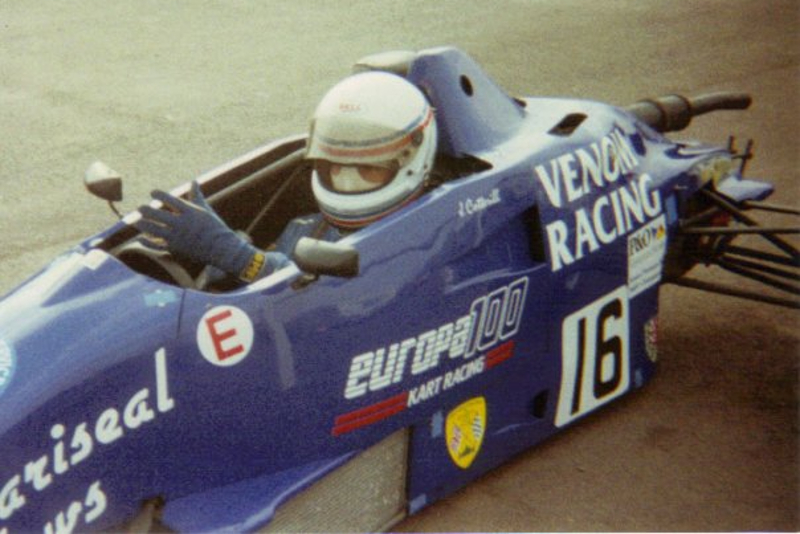
Photo: Wayne Pearson / Heroes of FF1600
“It’s always nice to see [this success], but we kind of – expected is probably too big a word – were reasonably confident after post-season testing, knowing where we, thinking we know where we are with varying things over the last two-and-a-half years now,” he said to Formula Scout at Spa-Francorchamps.
“F2 has been good. And F3 has also been, finally in Budapest we showed what we should have been showing earlier on in the season.”
MP took pole and won both FIA F3 races at the Hungaroring with Collet and Alexander Smolyar, a year on from failing to score any points at the track and qualifying no higher than 20th.
“It burns in my brain, if you look at our performance on F3 in Budapest last year, it was a complete turnaround. There was many hours of analysis to who, what and how that happened, but we were proved correct [with our approach this year].”
As many of MP’s technical hires have worked for Prema, a team with lots of F2 and F3 success, is there a certain degree of Prema influence in the approach that has come in?
“The approach is not something you can – having worked with Paolo now for two-and-a-half years, what he instigated here is not something that can be done overnight. We had a three-year plan, and more or less it’s on schedule,” Cotterill explained.
“The F2 engineering side is Paolo’s baby, and of course we have lots of crossover points [in responsibility], but it’s his baby as far as this is concerned. He’s also heavily involved with F3 as director of engineering across F2 and F3.
“Some of [the changes are] structural. His beliefs as to how you should develop and run the car, is pretty strict and fixed. Which I think is everybody’s structure, and he’s quite strong in it doesn’t go on the car until it’s proven. So we can have as many ideas as we want, we can put them all on the table and we can talk about them, analyse them, do whatever with it, but in the end he’s quite strict in that fundamentally the car is fixed until proven otherwise. And then when it’s proven.

Photo: Formula Motorsport Limited
“And that’s the thing that Paolo, in my opinion, he takes some convincing to make sure that it’s proven. So what that means is that you’re fairly confident when you do make a change, that it’ll be positive [for the car]. So from that point-of-view, it’s good.
“I’m not saying we’re doing any more or any less than other teams, but I’m sure that we, like most teams, have our own idiosyncrasies as to how it all should be. So all in all, I think every year it’s been positive. 2020 was fairly obviously positive, ‘21 on F2, we didn’t win as many races in ‘21 as we did in ‘20, which was disappointing, but still we stayed on the line in terms of as the progression is concerned. 2021, Paolo started to take more heavy involvement with F3 [and that improved too].
“There’s no magic to any of it. There is no magic to motorsport. We all think that there is or hope that there is. I’ve been in motorsport myself probably longer than I care to remember. People say you only get out of life what you put in, and I think in motorsport you only get out half of what you put in. It is intense and you’re competing against people with the same level of drive. So it’s hard work. Because like anything, if you stand still you go backwards.”
Cotterill reiterates that the changes have been “a gradual process”, but clearly once it was decided in late 2019 that MP was embarking on a three-year plan with new personnel, no time was wasted in making things happen.
“I’m trying to think back over those three years since Paolo came in as to what was not normal at the time, that is now normal,” continued Cotterill. “And not one specific thing. But lots of different small changes. But changes everywhere.
“So it was not just ‘okay, let’s focus on this’. Although Paolo, one thing that sticks in my mind is that he’d sat down with the engineers and said ‘ok, this is my plan, this is what I need to get covered’. So it was A, B, C, D.
“I remember in the next meeting when they all sat down, and everybody went:
‘So we’ve done A, B, C, he’s done D.’
‘Okay, great, next.’
‘What do you mean next? We’ve done it.’
‘Yeah, you’ve done A, B, C & D. We’ve got to go all the way to Z here. So I don’t want to lay it all on you in one hit.’
“At that point in 2019, I was at MP covering on some engineering with the cars, and Paolo just kind of arrived one morning and it was not a shock, but it was ‘okay, this is the chapter one’ that we needed. And to be fair we needed to do something.
“Because it’s like everything in motorsport, it’s a Catch 22. You need good drivers, that’s for sure. But to attract good drivers you’ve got to be quick. But without the good drivers you can’t be quick, necessarily. And of course the cars have got to be able to back up the driver, but the driver’s got to be able to back up the car as well.
“Felipe came in 2020, did a great job, gelled really well with the team and with Paolo and was working extremely well. So I think after Felipe’s season of F3, which always surprises me a little bit anyway with how people look at it, he came to us, with Paolo and Daniele, it was kind of start of the new regime. He clicked, it went well more or less from the first race.
“The pandemic was difficult because it was all switched off and then switched back on, and maybe helped MP in that we were in a transition period anyway. So to switch it off for a couple of months and to switch it back on was not about the same old, same old, it was – certainly from my own point-of-view, I had more time to get my head around where we were going, having had just a small period of time of these implementations.
“But to try to feed back to 2020, it was just different ways of working. Just the way that you want the mechanics to do it this way, not that way. Not that that way was wrong, but this is the way we want to do. Every single person within the team had to adjust. So me, Paolo, [team principal] Sander Dorsman, mechanics, everybody had to adjust.
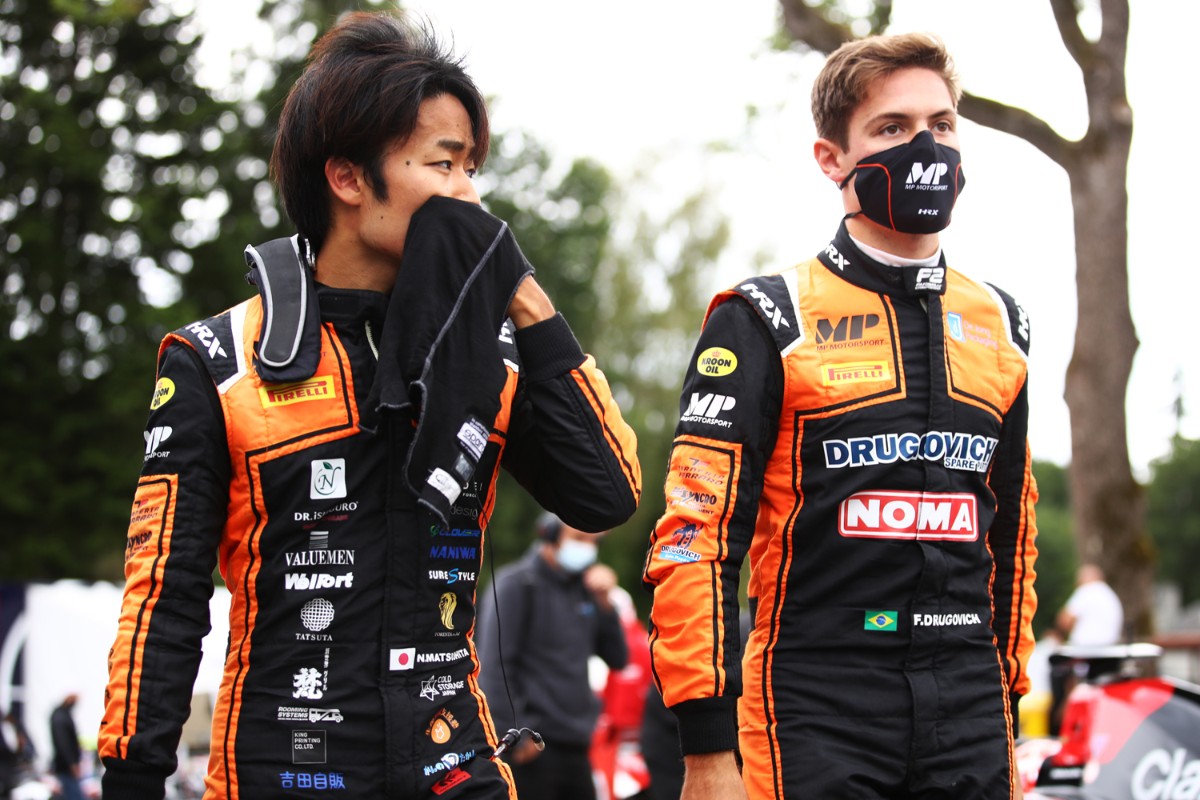
Photo: Formula Motorsport Ltd
“And it was not smooth, that’s for sure. We were, at that time, certainly in the beginning of ’20 and probably most of ’20, we were first in in the morning and last to leave at night. Because it takes some time to adjust.”
Drugovich had to adjust twice, after working to Virtuosi’s ways in 2021, and the productivity of the working relationship on his return has been another key to the team’s 2022 form.
“He trusts his engineers. They trust him. And I’m not saying everything’s all rosy in the garden and smiles all the time, it’s not. But in the end we can at least sit down as a group and try and least to work out any issues that we have. I don’t think any of us, Felipe, or the team, are ever sat there with no suggestions.
“Did the team get everything right this year? No. Did Felipe get us out of the shit sometimes? Yes. Did Felipe get everything right this year? No. Did the team get him out of the shit? Probably yes, on occasions. But that’s the way it’s got to work in the end, it’s a team.”
As Drugovich describes it: “Having that transparency with the top guys in the team, is very important so we can really get things out of our chest and make things straight between us, and that’s the way we go forward.”
One occasion where Drugovich was frustrated this year was in the Monaco feature race, where he led from start to finish but felt the wrong starting tyre compound was chosen and quickly went through his rubber. He said he was struggling with heavy steering through the race as he held off title rival Pourchaire for victory, but as Cotterill pointed out:
“To say that he was leading and struggling, he was defending from Theo. No one else. There wasn’t anybody else [near them] in the race. So we were ‘struggling’. I think the guy that was fourth would like to have been struggling that much.”
While Drugovich has already wrapped up the title, team-mate Clement Novalak has struggled all year to adapt to the car even though he has shown strong race pace on occassion.
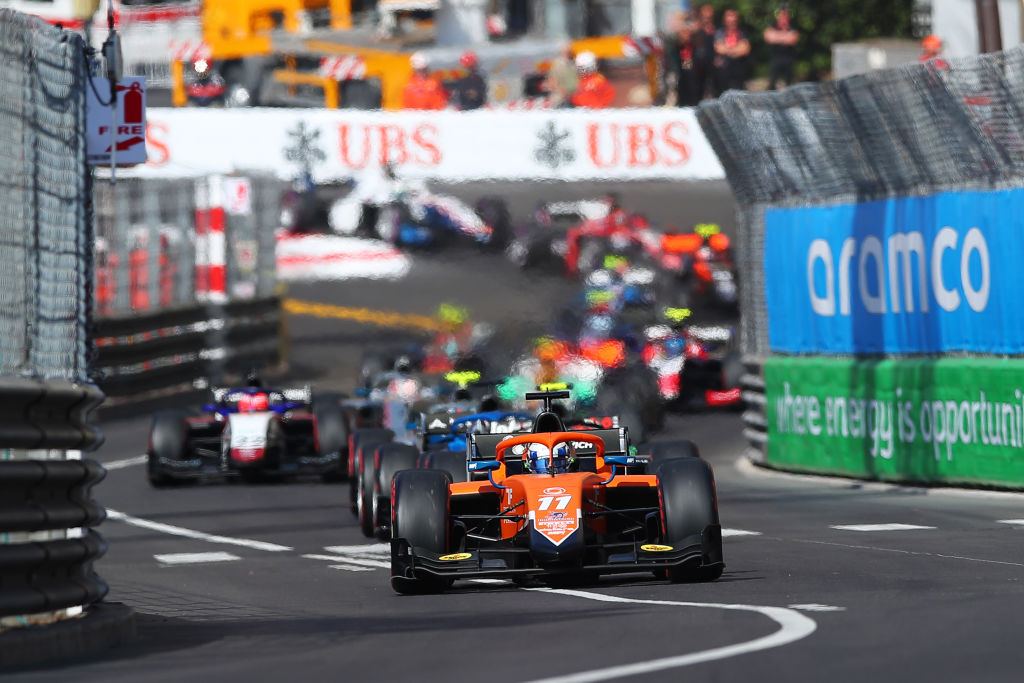
Photo: Formula Motorsport Limited
The team knows just as well as Novalak himself where he is lacking, and it all comes down to a driving style that does not correspond to the rather rigid demands of Pirelli’s F2 tyre construction and usually leaves him qualifying way down the order.
“One of the least surprised people to see Clem up there would be me. Probably one of the happiest people would be me, but the least surprised. It’s always just nearly there,” explained Cotterill.
“I look at Jeddah. He made a small mistake on that push, probably should have qualified fifth. With Felipe pole, Clem fifth, everything is good. But small things like that denting confidence, denting whatever. So keep coming back, keep coming back, keep coming back. In the end he’ll be better for it. I appreciate why people would look from the outside, but from the inside it’s not that bad.”
Drugovich describes Novalak as “one of the important parts of the team”. Not only in regards to “driving and set-ups”, but also “pushing the team forwards and the atmosphere becomes really, really nice with him”.
One of the remarkable things about MP’s rise up the F2 order is it currently tops the teams’ standings, and therefore is ahead of its expectations in its three-year plan, despite Novalak sitting 14th in the driver’s championship.
“When we sat down two-and-a-half years ago, we said it’s a three-year plan. But it wasn’t a three-year plan to be winning the championship. So I think if three years ago somebody had shown me the points table of two-and-a-half years down the line, I would have taken an arm off.
“And obviously there’s another three-year plan. After year one, the next three-year plan started. It’s just on a continual loop.
“But the next thing is to maintain it, bring [Clement’s] car closer to the other car, in an upward trajectory, that’s the plan. In 2024, it’s probably a new car so all the bets are off. And the workload I’m just thinking of now [for then], will be huge. To try to hit the ground running.”
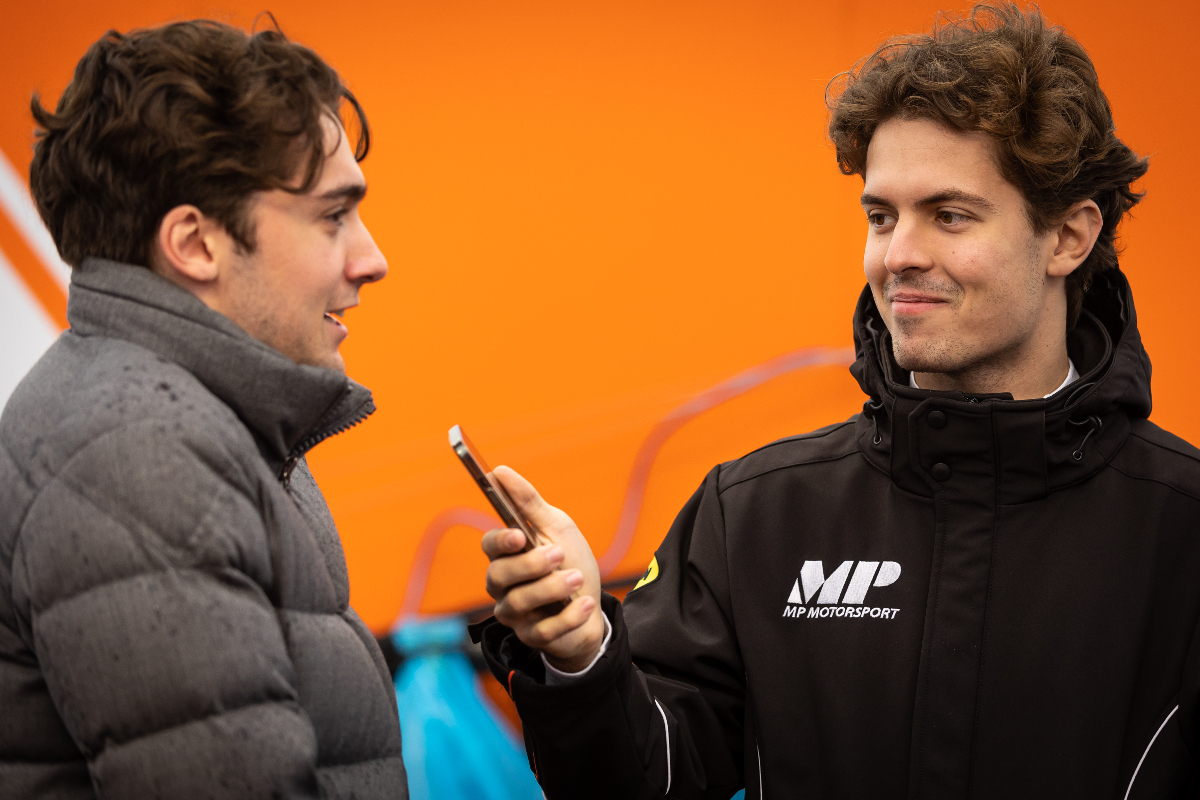
Photo: Formula Motorsport Limited
It is in MP’s interests for both cars to be scoring regularly, and Cotterill explained why Novalak’s lack of form is not related to any kind of focus towards one car over the other.
“For Felipe’s point-of-view, he would love to have a wingman. It would be perfect to have a wingman. So there’s absolutely no reason for us to put all the resources in [one car]. People said to me those sort of things over the years, and I look at it and think ‘well, what resources can we divert from there to there’. The engine is the engine, the car is the car. Both cars have everything that they need.
“Without question, if that’s what it needs, that’s what it has. I might moan about it sometimes and the mechanics are coming to me and saying:
‘I need one of these.’
‘You had one of them two weeks ago, why do you need another one? They don’t grow on trees, you know.’
“But they have it, they have what they need. And the engineers have what they need. They tell me this is what they need, then MP makes that happen. So I don’t know what resources you could divert.”
It is clear how MP has benefited from the people it has brought in, both to drive and run its cars, but one important factor that is hard to quantify is if there has been an opposite effect felt by their previous teams from their departure. New hires would have been made at those teams, and therefore their approaches would have evolved, as would the kind of feedback they recieve with different drivers. The never-ending cycle of professional sport.
MP’s 2021 line-up in F2 started off with rookies Richard Verschoor and Lirim Zendeli, but both ran out of budget and an all-new line-up of Jack Doohan and Novalak contested the final two rounds. Its highest placed driver was 11th in the standings.

Photo: Formula Motorsport Limited
“Last year didn’t look particularly impressive, but we had two rookies. Richard managed to win a race at Silverstone and was competitive [elsewhere]. But [rookies go] up and down over the course of the year,” said Cotterill.
“You’re still gaining information. Maybe not getting the recognition of what you think you’ve got because for whatever reasons this or that happened or didn’t understand that and didn’t react to this. But still, underneath it all we were monitoring where we were going, what we were doing and what’s right. And if at some point the team think that you’ve done something wrong, then wham you get it in the face. And the same the other way. Within a controlled reasonable way, but there’s no point in not saying.
“So last year, if we thought the drivers hadn’t driven it properly, they’d be told! You have not done what you’re supposed to do. And it’s like ‘uergh’. There’s multiple, multiple things. So last year didn’t look great, but still the underlying trend was still we’re on track [with our changes], we gain as much verification of where we were wanting to have by that point. The trend was still in the correct direction. And Felipe came back to us [off the back of that].”
The story of MP’s rise to top of the F2 table now makes a lot more sense, but there’s one more person whose side of the story is needed to fully explain it. A certain Paolo Angilella… Return to Formulascout.com on Sunday to read more
Words and Felipe Drugovich interview by Ida Wood. Jeremy Cotterill interview by Roger Gascoigne